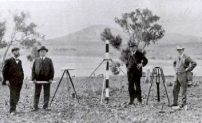Surveyor & Consulting Engineer
Location: CofE*V*225
A native of County Donegal, Ireland, Coane migrated to Australia in 1867 and worked for a number of years in Queensland before moving to country Victoria where he took up teaching with the Education department (1874-79). In 1879 he turned to a career in consulting and established a general surveying and civil, hydraulic and mining engineering practice. The firm went on to become one of the most distinguished of the era and undertook extensive work in the Yea and Seymour areas; new techniques were devised for levelling-in the steep country. Other work included the former Epsom racecourse at Mordialloc, the survey of Cape Otway forest, and water and irrigation works at Wonthaggi and Mildura.
President of the Victorian Institute of Surveyors (1890-91, 1905-06), he was often called on to provide expert witness in arbitrations and disputes. In 1912, Coane was appointed to chair the board who advised King O’Malley (d 1953) on the designs of the new Federal Capital for Canberra; he disagreed with other members on Burley Griffin’s design but was overruled. Later in life, with his son Henry Edward (q.v.) his firm “JM & HE Coane” were appointed consulting engineers to the State Electricity Commission under the chairmanship of Sir John Monash (q.v.). Locally, Coane was for many years municipal consulting engineer to the Brighton City Council (1899-1921) during which he oversaw road construction that were acknowledged as the best in the Commonwealth; he also advised the Brighton General Cemetery Trust.
He died at his daughter’s home in Kirribilli Point, North Sydney on 28 December 1923, amongst the many mourners who attended his funeral were William Allard (q.v.), OR Snowball (q.v.) and William McClelland (q.v.).
Source:
ADB Volume 7 1891-1939 (A-Ch).
The Argus 29 December 1923 & 9 May 1927.
The Age 29 December 1923 & 1 January 1924.
Brighton Southern Cross 5 January 1924.
Smith, J. (ed), “Cyclopedia of Victoria” (1903).
(Image by permission of the National Library of Australia, nla.pic-an24381693)

